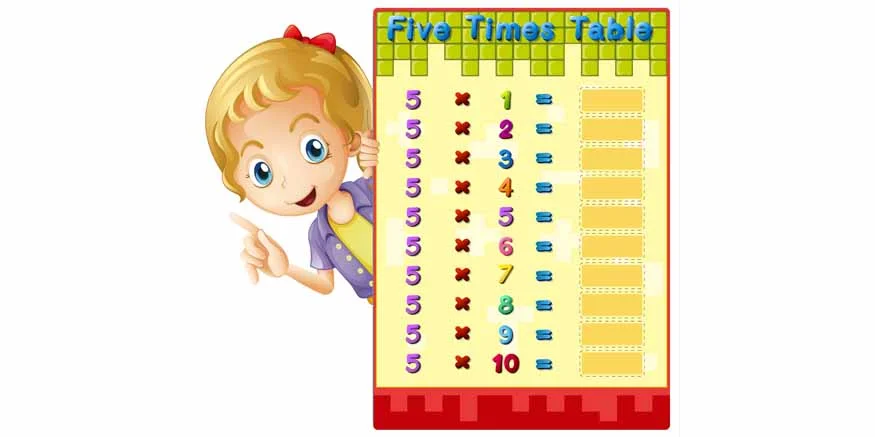Learning the fundamental concepts that lay the groundwork for a solid mathematical foundation is a thrilling journey through the fascinating world of mathematics for young minds. One of the most significant turning points in this journey is becoming an expert at multiplication tables. Here, we will examine the deeper significance of the 5 times table—a key idea in the field of multiplication—and offer a fun, approachable guide aimed at enhancing the mathematical abilities of our younger students.
Also read: Learn How to Memorise Multiplication Tables
Understanding the Basics
- Starting with 5:
- Easy Way to Learn Times Tables
- Visual Aid – The 5 Times Table Chart:
Starting a journey with numbers, we guide young learners to count in multiples of 5 – a journey that unfolds with 5, 10, 15, 20, and so forth. This essential practice is not just an introduction to the 5 times table but also introduces the concept of adding a number to itself constantly.
To bring enjoyment into the learning process, we encourage learners to associate multiples of 5 with familiar objects or daily activities. For instance, envision the number of fingers on one hand (5) and then ponder the total when both hands are considered. Through interaction, this method connects invisible parts of their everyday life with sophisticated mathematical concepts.
Complementing this journey, we introduce a visual aid in the form of a 5 times table chart. The following teaching tool provides a visual representation of the multiplication table of 5, revealing complex patterns and relationships that strengthen the cognitive components of retention of memory and promote greater depth of knowledge.
Exploring the 5 Times Table
- 5 times 1 = 5:
- Learning Times Tables Through Repetition:
- Patterns in the 5 Times Table:
- 5 Times Table:
- 5 x 1 = 5
- 5 x 2 = 10
- 5 x 3 = 15
- 5 x 4 = 20
- 5 x 5 = 25
- 5 x 6 = 30
- 5 x 7 = 35
- 5 x 8 = 40
- 5 x 9 = 45
- 5 x 10 = 50
Commencing with the number 5 itself, this basic understanding lays out the foundation for simpler multiplication operations by highlighting how simple it is that every number multiplied by 1 remains unchanged.
Going a step further, we stress that mastering the skills of multiplication requires repetition. Learning times tables is made lively and interesting by using techniques like games, flashcards, and quizzes, which also ensure that basic understanding stays in place through regular practice.
Examining details provides interesting patterns that are included in the 5 times table. It is important that the results’ unit digit changes from 0 to 5, displaying a pattern that can be used as a useful mental assist for quick and accurate calculation.
Also read: Best Maths Tricks That Will Turn Your Kids into A Maths Whiz
Applying the 5 Times Table
- Real-Life Applications:
- Practical Scenarios for the 5 Times Table:
By connecting academic knowledge with real-world application, we highlight the five times table’s practical uses. Imagine, for instance, that a youngster gets $5 for every task they finish. Under such circumstances, figuring out total profits reduces to a simple multiplication problem, demonstrating the relevance and usefulness of mathematical ideas.
By creating settings where young learners actively use the 5 times table, the practical factor is improved even more. These practical exercises, which can include counting objects in groups of five or separating a set of objects into equal parts, provide concrete applications that strengthen understanding and highlight the ability to adapt mathematical concepts.
Engaging Activities for Learning the 5 Times Table
Explore fun and interactive ways to teach young learners the five times table in an effective and enjoyable way.
- Fun Games and Exercises:
- Interactive Flashcards:
- Quizzes and Challenges:
Include engaging exercises and games in the learning process. Whether it’s a “multiply and move” exercise or a game of multiplication bingo, making learning enjoyable for children keeps them interested and motivated, which is an easy way to learn times tables.
Provide interactive flashcards with visual hints or tips that show multiplication issues. This multipurpose method takes into account various learning styles and promotes what has been learned.
Introduce tests and challenges on a regular basis to evaluate and maintain the knowledge you’ve learned. Friendly competitions or timed challenges add excitement to the learning process.
Also read: Real Numbers: Overview, Chart, and Properties
Tips for Memorisation and Recall
- Mnemonic Devices for Each Multiplication:
- Memory Boosting Techniques:
- Incorporating Daily Practice Routines:
Create mnemonic devices or memory aids for each multiplication in the 5 times table. Establishing a relationship between a fun phrase or image and each calculation makes memorization more enjoyable and effective.
Explore memory-boosting techniques such as visualisation. Encourage kids to create mental images or stories that connect to multiplication facts, enhancing their ability to recall information.
Consistency is key. Establish a daily practice routine where kids spend a few minutes reviewing the 5 times table. The constant encouragement plays an important part in lasting retention.
Common Mistakes and How to Prevent Them
- Addressing Common Misconceptions:
- Troubleshooting Challenges in Learning:
- Providing Additional Support and Guidance:
- Use Visual Tools:
- Practice Regularly:
- Employ Real-World Examples:
- Make Learning Fun:
- Give Positive Support:
Early detection and clearing up of common misconceptions facilitate a more certain and precise grasp of multiplication during the learning process and greatly add to a strong foundation in education.
Recognize and troubleshoot challenges that kids may face. Whether it’s difficulty with certain numbers or a lack of interest, tailoring the learning approach to address individual challenges is crucial.
Offer additional support and guidance when needed. Create a supportive learning environment by making sure that the classroom is organised and equipped with all the resources required to effectively encourage excitement and concentration.
To improve understanding while developing a more exciting and interesting atmosphere for learning, make creative use of flashcards, multiplication charts, and other visual tools.
Set aside dedicated time each day for multiplication practice, incorporating enjoyable activities to maintain high levels of motivation and engagement.
Also read: 15 Hands- On Math Activities for Preschoolers
To strengthen understanding practically, show how multiplication is applied in real-world scenarios like distributing groceries equally among siblings or calculating shopping prices.
Utilise various games, puzzles, and tasks to provide your youngster with an interesting, amazing, and engaging learning experience.
To help your child develop a positive attitude towards learning and self-confidence, give them constant praise and encouragement throughout their educational journey. Recognize their effort and progress.
Conclusion
The 5 times table is crucial in a child’s maths journey. Starting with basics, interactive activities, practical tips, and parental involvement ensure a strong foundation. Our goal: to empower young learners, fostering a lifelong love of maths and learning.
To guarantee a complete understanding, EuroSchool’s technique includes interesting lessons, fun tasks, and practical examples. EuroSchool’s primary goal is to establish a welcoming and fun learning atmosphere, encouraging participation in a variety of 5 times table-related activities. EuroSchool seeks to encourage a lifetime appreciation for learning in addition to improving mathematical ability through the celebration of achievements and advancements.









